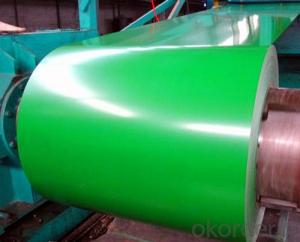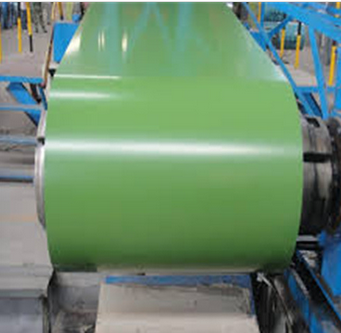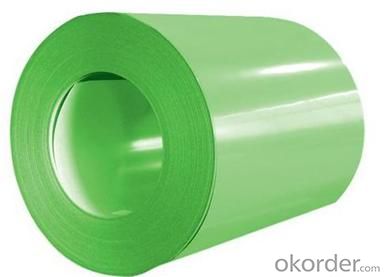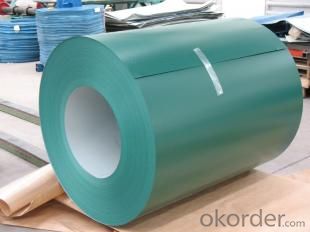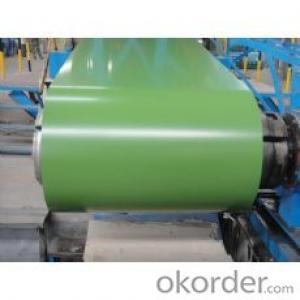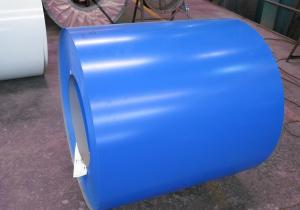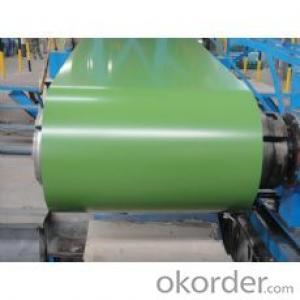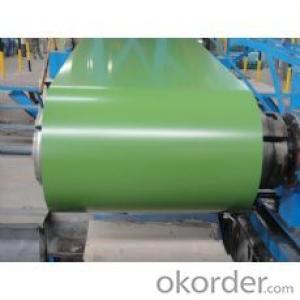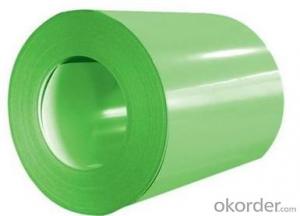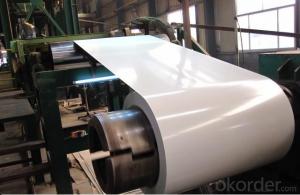Pre-Painted Galvanized Steel Sheet/Coil with Best Quality Green Color
- Loading Port:
- Shanghai
- Payment Terms:
- TT OR LC
- Min Order Qty:
- 100 m.t.
- Supply Capability:
- 10000 m.t./month
OKorder Service Pledge
OKorder Financial Service
You Might Also Like
1. Pre-Painted Galvanized/Aluzinc Steel Coil Description:
With GI as base material, after pretreatment (degrease and chemical treatment ) and liquid dope with several layers of color, then after firing and cooling, finally the plate steel is called pre-painted galvanized (aluzinc) steel. Pre-painted galvanized steel is good capable of decoration, molding, corrosion resistance. It generally displays superior workability, durability and weather resistance.
2.Main Features of the Pre-Painted Galvanized/Aluzinc Steel Coil:
• Excellent process capability
• Smooth and flat surface
• Workability, durability
• Excellent heat resistance performance
• High strength
• Good formability
• Good visual effect
3.Pre-Painted Galvanized/Aluzinc Steel Coil Images
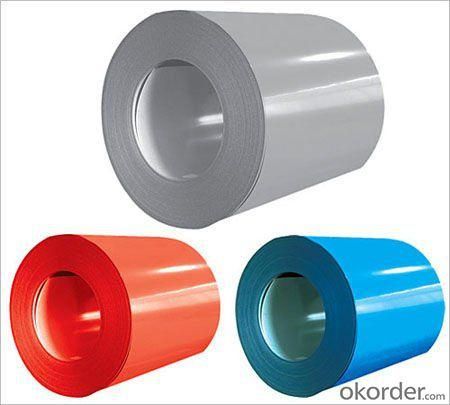
4.Pre-Painted Galvanized/Aluzinc Steel Coil Specification
Standard: AISI, ASTM, BS, DIN, GB, JIS
Grade: DX51D, DX52D
Thickness: 0.17-2.0mm
Brand Name: KMRLON
Model Number: coil
Type: Steel Coil
Technique: Cold Rolled
Surface Treatment: Coated
Application: Boiler Plate
Special Use: High-strength Steel Plate
Width: 20-1250mm
Length: customized
commoidty: pre-painted galvanized steel coil
Thickness: 0.13-4.0mm
width: 20-1250mm
zinc coating: 40-180g/m2
printing thickness: top side: 20+/-5 microns, back side: 5-7 microns
color: all RAL color
surface treatment: color coated
coil weight: 4-7 tons
coil ID: 508/610mm
packaging: standard seaworthy packing
5.FAQ of Pre-Painted Galvanized/Aluzinc Steel Coil
1. What’s the application of this product?
Roof, roof structure, surface sheet of balcony, frame of window, etc.
2. What’s the brand of the paint?
We use the best brand of all of the word—AKZO.
3. How to guarantee the quality of the products?
We have established the international advanced quality management system,every link from raw material to final product we have strict quality test;We resolutely put an end to unqualified products flowing into the market. At the same time, we will provide necessary follow-up service assurance.
4. How long can we receive the product after purchase?
Usually within thirty working days after receiving buyer’s advance payment or LC. We will arrange the factory manufacturing as soon as possible. The cargo readiness usually takes 15-25 days, but the shipment will depend on the vessel situation.
- Q: What are the different types of steel coil grades and specifications?
- There are several different types of steel coil grades and specifications, including hot rolled, cold rolled, galvanized, and stainless steel coils. Each type has its own unique properties and uses. Hot rolled coils are produced at high temperatures and are commonly used in construction and manufacturing applications. Cold rolled coils are produced at lower temperatures and have a smoother finish, making them suitable for applications that require a higher level of precision. Galvanized coils are coated with a layer of zinc to protect against corrosion, while stainless steel coils contain a high percentage of chromium for added durability and resistance to corrosion. Overall, the choice of steel coil grade and specification depends on the specific requirements of the project or application.
- Q: What is stainless steel coil used for?
- Stainless steel coil is primarily used in various industries for its durability, corrosion resistance, and aesthetic appeal. One of the most common applications is in the manufacturing and construction sectors, where stainless steel coils are utilized to produce a wide range of products such as kitchen appliances, cutlery, automotive parts, and architectural structures. The corrosion-resistant properties of stainless steel make it an ideal choice for applications that require resistance to moisture, chemicals, and harsh environmental conditions. Additionally, the high strength and heat resistance of stainless steel coils make them suitable for use in industrial equipment, heat exchangers, and piping systems. Moreover, the aesthetic appeal of stainless steel, with its sleek and modern appearance, is often preferred in the design and production of consumer goods, including furniture, jewelry, and decorative items. Overall, stainless steel coil is a versatile material that finds extensive usage across various industries due to its excellent mechanical properties, resistance to corrosion, and aesthetic versatility.
- Q: how simple is it to take it scrape steel and recyle it. does annybody know the process . i want to do this but first i need some basic information. as far as i know first to melt the steel and in a furness on high heat and than give the shape that customer wants. how right or wrong am i . i want to start on a very small scale.
- You okorder /... mini-mills operate between 150,000-2million tons of steel per year. If that is the size you were thinking about... you are in business. But since you are asking on Yahoo Answers where no serious industrialist would EVER ask a question like this, I can only assume that your ideas of small are completely incompatible with reality.
- Q: I've seen on TV that stainless steel laminate sheets can be purchased and and used to cover appliances to give it a faux stainless steel look. They mentioned it was important to not have any bubbles (of course) and to work slowly. It's easy to do on a dishwasher, but what about the fridge? The handles are in the way? Do you have to take the handles off? Can anyone find a tutorial for me?
- There okorder appliance paint 2. What you are referring to really is not laminate steel sheets, it's actually more along the lines of shelf liner paper looks like steel with sticky back film that you peel and stick. Place against product and begin to peel down slowly using squeegee or credit card to smooth out bubbles.Sheets can be purchased rangingin size on OKorder for $9.99 + dependent on size. Called stainless steel appliance film can buy a roll for $60.00 on OKorder (normally sells for $100.00) one roll will cover 3 average sized kitchen appliances. Hope this helps!
- Q: i see a lot of connexes say repair only with corten steel. what is the difference between corten steel and regular steel. and if i was going to stick weld it what type of electrode would i use?and while i'm at it what is the best electrode to use when welding galvenized steel?
- 6010 and 6011 Electrodes for welding galvenized steel. Weathering steel, best-known under the trademark COR-TEN steel and sometimes written without the hyphen as Corten steel, is a group of steel alloys which were developed to obviate the need for painting, and form a stable rust-like appearance if exposed to the weather for several years. The corrosion-retarding effect of the protective layer is produced by the particular distribution and concentration of alloying elements in it. The layer protecting the surface develops and regenerates continuously when subjected to the influence of the weather. In other words, the steel is allowed to rust in order to form the 'protective' coating. For welding corten steel: 1A.W.S ClassificationE 7018 - 1AWS A 5 - 1 - 78 2IS classificationE 5424 JXIS 814 (Part I II)H 3BS classificationE 51.54 B 12 17HBs 639 - 1976
- Q: I heard that titanium isn't the most hypoallergenic metal because it is treated and the chemicals can cause an allergic reaction. I also heard that surgical steel is the best because it is what is used in surgery and in hip replacement implants etc. Is this correct?I've always heard that titanium is best, but now I'm curious because surgical steel is much cheaper than titanium which can be expensive.Thanks
- There is a lot of debate in the piercing community about guns vs. needles. In my opinion, needle piercing from a reputable piercing shop is the best choice. This is because guns can harbor a lot of bacteria, especially if they are used on more than one person which they often are. Yes, guns are fast and efficient, but they can be unsafe at times. My first lobe holes were done with a gun. I cried forever because it burned so bad...even after days. They lady was so impersonal, and they used sterling silver which I found out that day I was allergic to. My other 4 holes are were done with a needle. I had trouble healing them because I used sterling silver (my stupid fault), but besides the allergy, they healed beautifully and were virtually pain free. I would recommend getting them pierced at an actual shop, not the mall. If I were you, I would chose niobium metal or titanium to avoid any type of allergy that could happen. Choose studs and not rings because they are easier to heal. Good luck!
- Q: I want to buy a machete made of 1055 carbon steel, and want to know if this steel is durable for repeated use, or even combat use.
- From okorder /
- Q: How are steel coils used in the manufacturing of industrial mixers?
- Steel coils are used in the manufacturing of industrial mixers as they are typically used to construct the main body and structural components of the mixer. The coils are formed into the desired shape and size, providing strength, durability, and stability to the mixer, allowing it to withstand the rigorous mixing processes involved in industrial applications.
- Q: What are the different types of steel coil transport methods?
- There are several different types of steel coil transport methods, including flatbed trucks, coil racks, coil cradles, and coil trailers. Each method offers unique advantages and is used based on factors such as coil size, weight, and transportation requirements.
- Q: How do steel coils perform in corrosive environments?
- Steel coils perform well in corrosive environments due to their inherent resistance to corrosion. The protective layer of oxide on the surface of steel, along with the addition of corrosion-resistant coatings, helps prevent the coils from rusting or corroding when exposed to moisture or chemicals. This makes steel coils ideal for various applications in corrosive environments, such as transportation, construction, and manufacturing industries.
Send your message to us
Pre-Painted Galvanized Steel Sheet/Coil with Best Quality Green Color
- Loading Port:
- Shanghai
- Payment Terms:
- TT OR LC
- Min Order Qty:
- 100 m.t.
- Supply Capability:
- 10000 m.t./month
OKorder Service Pledge
OKorder Financial Service
Similar products
Hot products
Hot Searches
Related keywords
